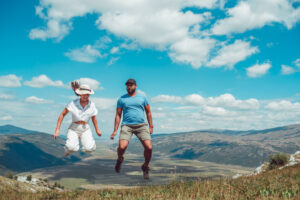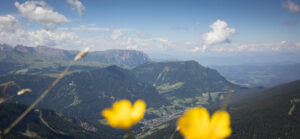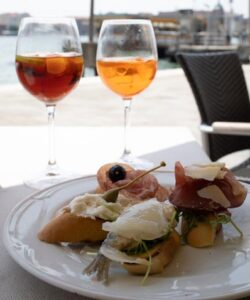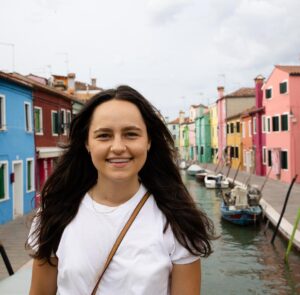The Dolomites is one of those places that just doesn’t feel real.
Rolling meadows decorated with colourful wildflowers nestled between hillsides covered in thickets of trees, all culminating in gigantic rocky peaks jutting out into the heavens… it feels like stepping into a fairytale.
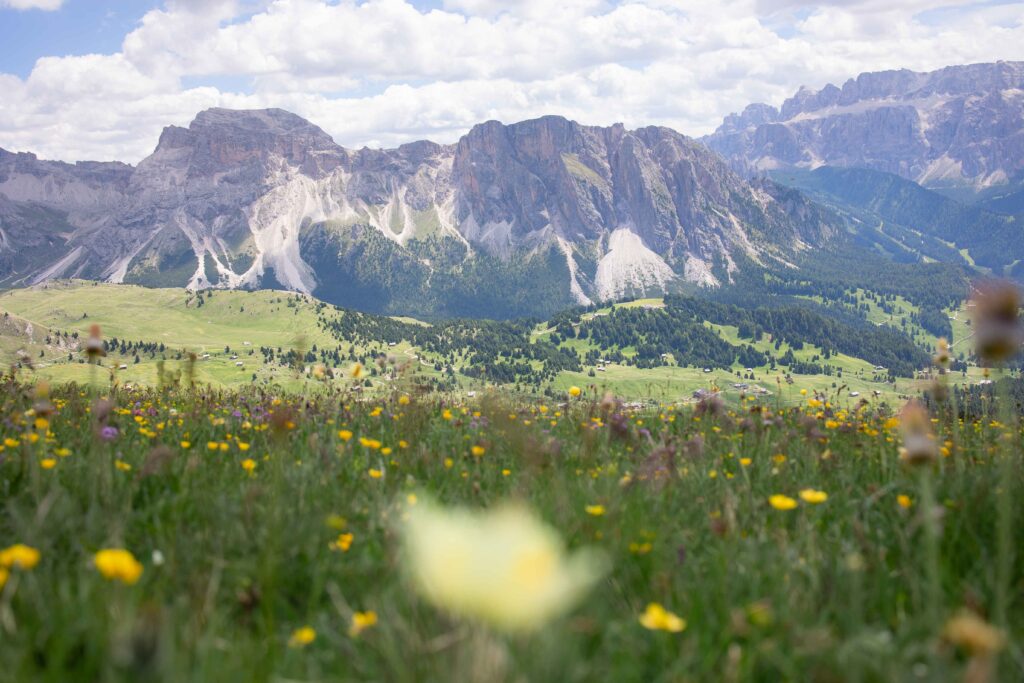
I’m lucky to have spent 9 blissful days there, and have documented my best advice on how to experience the magic of this special place, all without a car. So, if you’re on the fence, I’m here to tell you that it’s easy and absolutely worth it!
Backstory: Huzai and I originally intended to rent a car, but when we went to book one (albeit very last minute), we found that there were only a handful of overpriced options available. We decided to try it without a car, and needless to say, we’re so glad that we did!
This guide covers all the essential things you need to know before you start planning your first (or perhaps even second) trip to the Dolomites: where the Dolomites are and which towns are best to base yourself in without a car, how to get to the Dolomites without a car, advice on finding your accommodation, when the best time of year is to visit, a perfectly crafted 5 day itinerary for visiting in the summer, how to get around to various hikes and attractions without a car, and tips on what to eat and drink while you’re there.
I hope you find this guide useful and would love for you share your thoughts in the comments at the end!
1. What / where are the Dolomites
The Dolomites is a mountain range in the north eastern Italian Alps, with 18 peaks rising above 3000 metres. It is protected as a UNESCO world heritage site for the aesthetic value of its beautiful landscape and the scientific importance of its geology.
Though the Dolomites is technically part of the Alps mountain range, it is quite distinct in its appearance. The peaks tend to look more rugged, and at dawn and dusk they exude a pinkish glow due to the large amount of dolomite mineral found in their rocky walls. In Italian, this phenomenon is lovingly referred to as Enrosadira.
The protected mountain range covers more than 140 thousand hectares that sprawl across three distinct regions of Italy (Veneto, Trentino-Alto Adige / South Tyrol (Südtirol), and Friuli Venezia Giulia). The Dolomites only recently became Italian during WWI, when the Italians annexed the previously Austro-Hungarian Empire-ruled region.
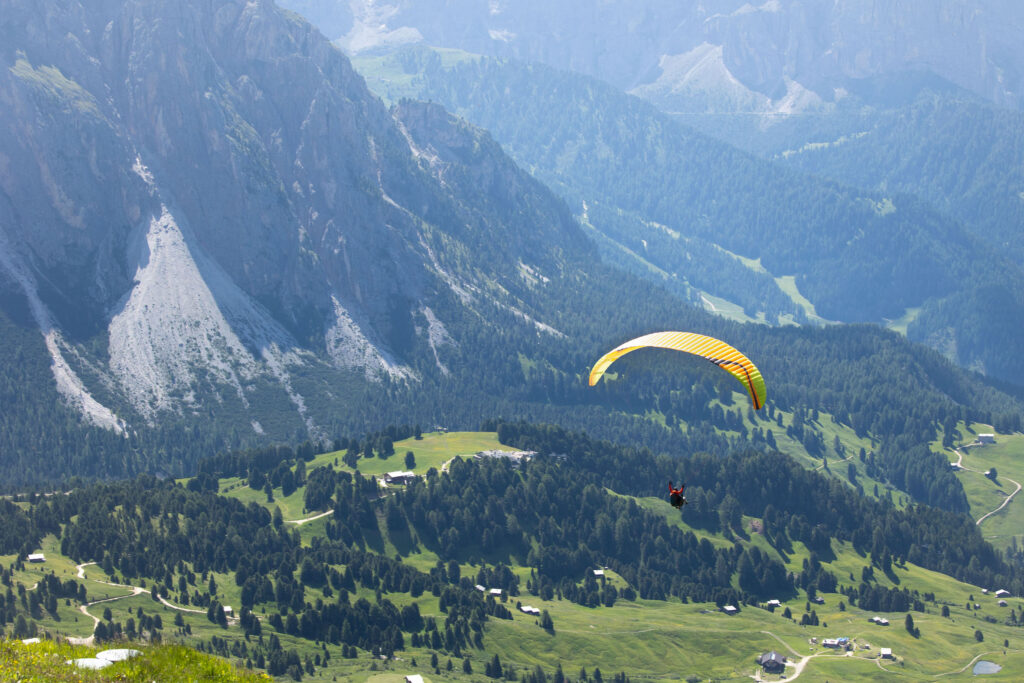
2. What is the Dolomites known for
It’s known for hiking, mountain climbing, cycling and paragliding in the summer, and snow sports like skiing, snowboarding, snow shoeing in the winter.
It’s also known for hypnotic photos of alpine lakes and lonely mountain huts, thanks to Instagram.
Less known and harder to photograph is the Dolomites’ vibrant culture, stemming from its history which dates back many millennia.
Before people were even around, the Dolomites was once an enormous coral reef, formed in the primordial ocean, Tethys. You can see fossils from the primordial ocean creatures in museums across the region. From prehistoric times, to the earliest records of humans in the stone age, to the period of Roman rule, to the Middle Ages, to WWI and WWII, through to today, the region has experienced so much transformation.
The region’s rich history is very much alive today in its people’s traditions, food and languages (there are 3 official languages in the Dolomites: German, Italian and Ladin… which means that everything has 2 or 3 names, including town, road and trail signs… fun times) and is definitely worth spending time learning about during your stay.
The Dolomites is a place to indulge in the best wine, eat delicious tagliatelle alla tartufo and speck, and experience for yourself.
3. Where to stay in the Dolomites without a car
There are so many great options when it comes to choosing where to base yourself. However, if you are travelling without a car, there are some important criteria you’ll want to consider. You’ll want to choose a base that:
- Is easy to get to without a car
- Has accessible day hikes and points of interest
- Has a variety of restaurants, cafes, bars and and other amenities within walking distance
Based on this, if you are visiting for the first or second time, in the western Dolomites, the Val Gardena area makes the most convenient base, and on the eastern side, the town of Cortina d’Ampezzo is your best bet.
From Val Gardena, you will be closer to sights including Alpe di Siusi, the Seceda ridgeline, Resciesa, and the Sassolungo group.
Staying in Cortina d’Ampezzo, you will be closer to different but equally beautiful sights, like Cinque Torri, Giau Pass, Lago Federa, Tre Cime di Lavaredo and Lago di Braies.
While Val Gardena and Cortina d’Ampezzo both have impressive hikes and views in their vicinities, there are a few things that give Val Gardena an edge:
Why you should stay in Val Gardena
- Val Gardena has access to different hikes, landscapes and sights from a more compact area.
Access to most of the hikes in Val Gardena is contained within about a 5 km radius. This means you just need to walk 5-10 minutes to one of the lifts in town or take a short bus to a lift in one of the neighbouring towns in the valley. In Cortina on the other hand, most of the hikes and attractions are at least a 30 minute bus ride away from the town centre. - Public transportation is free for visitors within the valley.
All overnight visitors of Val Gardena can use any bus in the area for free throughout their stay via the Mobil Card, as long as your accommodation is a member of the Tourist Association (which almost all of them are). - Val Gardena has the longest summer season in the Dolomites.
In most places in the Dolomites, amenities including hotels, cableways, and mountain huts are open only from late June through September. However, in Val Gardena, many amenities stay open through October and later.
The bottom line: Val Gardena (specifically Ortisei – more on Ortisei below), is the top choice if you are travelling to the Dolomites for the first or second time time (i.e. you haven’t already experienced the main attractions around Val Gardena like Alpe di Siusi, the Seceda ridgeline, etc.) and won’t be using a car. While there are other destinations that are also easy to reach via public transportation and have great amenities, Val Garden wins out because the area has the most access to awesome day hikes within a short walk or bus ride from your accommodation and has free public transport for visitors that connects all 3 towns / villages in the valley.
Where to stay in Val Gardena
Val Gardena is composed of three lovely little mountain towns within a 10 km radius of each other: Ortisei, Santa Cristina and Selva. Which one you should choose to stay in really depends on what you’re looking for.
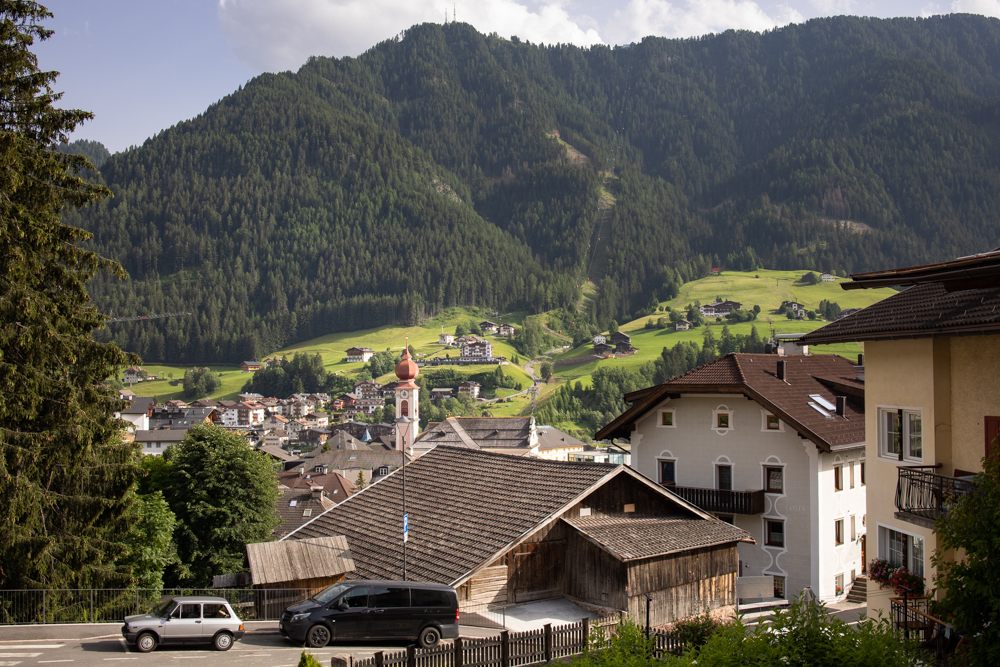
Ortisei is largest and the liveliest of the three, featuring a good selection of restaurants, bars and cafes and a pedestrian zone that’s perfect for evening strolls. It’s the closest to well-known sights like the Seceda ridgeline, Resciesa, and Alpe di Siusi. We enjoy food and convenience, so this was an easy winner for us and is where we stayed during our trip.
Santa Cristina is the smallest and is centrally located in the heart of the valley. While it doesn’t have the same level of amenities as its neighbours, it also feels the least “commercialized” and tends to get less crowded.
Selva di Val Gardena sits at the foot of Sella Massif, one of those mountains in the Dolomites that just takes your breath away. You can find incredible views of the Sella Massif from throughout the village, including from some of the accommodations. Also, thanks to its positioning at the highest elevation in the valley, Selva tends to have cooler temperatures, so it can be more comfortable on hot summer days.
The bottom line: While the towns are well connected enough that you could choose any of them as a base, Ortisei stands out because it’s the most accessible for getting to major attractions including the Seceda ridgeline, Alpe di Siusi and Receisa. Also, it’s the most convenient in terms of amenities (i.e. there are lots of great food options :).
4. How to get to the Dolomites without a car
Ortisei and Val Gardena in general are very well connected, so getting there without a car won’t be an issue.
There are plenty of airplane, train and bus options which I’ve outlined below.
By plane
If you are flying in for the trip, there are 10 airports that service the area and have some combination of train, bus and taxi connections available that will get you to Val Gardena in no time. You should fly in to the airport that makes the most sense for you based on flight availability, cost, time, etc.
Below are the airports in order of distance from Ortisei:
- Bolzano (BZO): 40 km
- Innsbruck (INN): 120 km
- Verona (VRN): 190 km
- Treviso (TSF): 190 km
- Bergamo (BGY): 270 km
- Venice (VCE): 270 km
- Munich (MUC): 300 km
- Milano (MXP): 350 km
- Salzburg (SZG): 320 km
- Zurich (ZRH): 420 km
To get from the airport to Ortisei, there are train, bus and shuttle options available.
Getting from the airport to Ortisei by train
If you are travelling by train or bus, you will need to get to Bolzano first. All of the cities mentioned above have trains that go to Bolzano. Check out the links below for prices and timetables:
- Innsbruck (INN) to Bolzano
- Verona (VRN) to Bolzano
- Treviso to Bolzano
- Bergamo to Bolzano
- Venice to Bolzano
- Munich (MUC) to Bolzano
- Milano to Bolzano
- Salzburg (SZG) to Bolzano
- Zurich (ZRH) to Bolzano
For details on how to get from Bolzano to Ortisei, check out the Getting from Bolzano to Ortisei section below.
Getting from the airport to Ortisei by bus
As mentioned above, if you are travelling by train or bus, you will need to get to Bolzano first. A budget-friendly option to get you to Bolzano from the airport is Flixbus, which offers service from all of the 10 airport cities mentioned above to Bolzano. Check out the Flixbus website for prices and timetables.
Note that some of the airports listed above don’t have a Flixbus bus stop at the airport itself, so you will need to use local transit to get from the airport to the bus stop.
For details on how to get from Bolzano to Ortisei, check out the Getting from Bolzano to Ortisei section below.
Getting from the airport to Ortisei by shuttle
A super convenient option is the AltoAdigeBus airport shuttle, which offers direct transfers from all of the major airports in northern Italy, Austria, and Germany listed above to Ortisei. Check out the AltoAdigeBus website for timetables and pricing.
By train
Travelling by train optimizes for the things I care about the most – speed, comfort and environmental impact, so it’s my favourite way to get around, especially in Europe.
You will need to get to Bolzano first, and then take a local bus, shuttle or taxi to Ortisei.
Check out the links below for prices and timetables:
- Trenitalia or Italo (Italy)
- Deutsche Bahn (Germany)
- ÖBB (Austria)
- SBB (Switzerland)
- Trainline
For details on how to get from Bolzano to Ortisei, check out the Getting from Bolzano to Ortisei section below.
By bus
A great low-cost option to get to Ortisei if you are travelling from a nearby region such as northern Italy, Germany, or Austria is to take a bus. As mentioned, you will need to get to Bolzano first, and then take a local bus, shuttle or taxi to Ortisei.
For route information, timetables and pricing, check out the bus companies below, all of which offer bus service to Bolzano:
By carpool
Carpooling is a great way to get to your destinations and perhaps meet some new friends on the way. Check BlaBlaCar or another carpool platform for rides to Val Gardena from your area.
Getting from Bolzano to Ortisei
From Bolzano, you can get to Ortisei via public transit, the Sudtirol Transfer shuttle service, or taxi.
Public transit: take the 350 line from Bolzano to Ortisei. You can use the Suedtirol Mobil journey planner here and download PDF timetables for 2023 here or 2022 here.
Shuttle bus: arrange to get picked up from the bus or train station in Bolzano and be driven to your accommodation in Ortisei. Check out the Sudtirol Transfer website for prices and timetables.
Local taxi: contact a local Val Gardena taxi company and arrange to be picked up and dropped off whenever is most convenient for you. Check out the Val Gardena website for a list of companies and their contact info.
Depending on your chosen mode of transportation, it takes between 40 minutes to an hour of winding through the mountain roads to get from Bolzano to Ortisei. The views are incredible and will get you pumped to explore the mountains. The trip from Bolzano to Ortisei pretty windy. If you’re like me, and windy mountain roads tend to make you nauseous, keep some spearmint or peppermint mints or chewing gum handy for the ride. This has always been a lifesaver for me!
5. Accommodation in Ortisei
We were blown away by the incredible hotels and B&Bs in Ortisei. While there are plenty of great options, many were unavailable by the time we were looking to book (which was only a few days before we planned to leave).
Insider tip #1: Val Gardena is one of the most popular places in the Dolomites and gets a lot of both local Italian and international visitors year-round, so more often than not, the nicest and best-value-for-dollar places are booked months in advance. Don’t be like me, and book your accommodation in Ortisei as soon as you confirm your travel dates.
Insider tip #2: Many of the accommodations in Val Gardena require you to stay for a minimum of 3 nights, and some even require 7 nights. They will show up as unavailable on the booking websites if you search for a shorter duration stay. Keep this in mind when you’re looking for your accomodation.
Below are my recommendations depending on your budget.
Budget | Hotel Garni Plances
We got lucky with our last minute-booking and snagged a stay here for 8 nights, and I couldn’t recommend it enough!
The location is perfect – it’s situated in the heart of Ortisei, steps away from 2 grocery stores, 200 m from the Alpe di Siusi lift and 300 m from the Seceda lift.
It offers both en suite rooms as well as apartments, most with a balcony. The interior is thoughtfully designed, with lots of cozy wooden finishes. The rooms overlook the main promenade or the grassy hillsides across from the southern (back) side of the building.
Their breakfast buffet is a real treat, with amazing local & seasonal products (think fresh eggs, artisanal bread, homemade wild blueberry jam, and the creamiest ricotta cheese… *wipes drool*.
Included with your stay, you get access to a great nearby spa and wellness facility, with a 25-metre indoor lane pool, outdoor & saltwater pools, saunas, steam rooms & Turkish baths. The facility gets busy in the evenings with lots of families and children once everyone is done with their activities for the day, so try to avoid going between 6 pm and 8 pm if you’re looking for some quiet time.
The owner is incredibly kind and always available to answer questions and dish out insider tips.
Mid-Range | Casa al Sole
Casa al Sole is conveniently located in Otisei town centre, 350 m from the Seceda lift and 450 m from the Alpe di Siusi lift.
It has newly renovated en suite rooms designed with meticulous attention to practical living, some of which feature a mountain view.
Wonderful à la carte, continental or Full English/Irish breakfast can be enjoyed at the property. It also has a lovely bar with a thoughtfully curated wine, beer and cocktail menu to wind down after a long day of hiking.
The owners are repeatedly praised by guests for their warm hospitality and for going above and beyond to make sure guests have an amazing experience.
Luxury | Hotel Angelo Engel
Hotel Angelo Engel is situated in the centre of Ortisei, 600 m from the Seceda lift and 500 m from the Alpe di Siusi lift.
The alpine style rooms are elegant without compromising on comfort, including bath robes and slippers for each guest. Most rooms have a balcony.
The hotel features all the amenities you could think of. Guests especially appreciate the traditional South Tyrolean food served at the restaurant and the varied breakfast buffet offered each morning.
The spa area is another guest favourite, and includes an indoor pool, a hot tub, a Turkish bath, several saunas and an outdoor heated pool with a hydromassage area available for use year-round. Beauty treatments and massages are also available.
Free hiking excursions are offered in the summer.
6. Best time of year to visit
The inconvenient truth is that every season in the Dolomites is special in its own unique way.
Huzai and I visited during the last week of June, which worked out perfectly for us. We felt like we got to experience all the advantages of the summer season (ideal weather, wildflowers in full bloom, all of the amenities like mountain huts, restaurants and cable cars being open) before the summer tourist crowds picked up July.
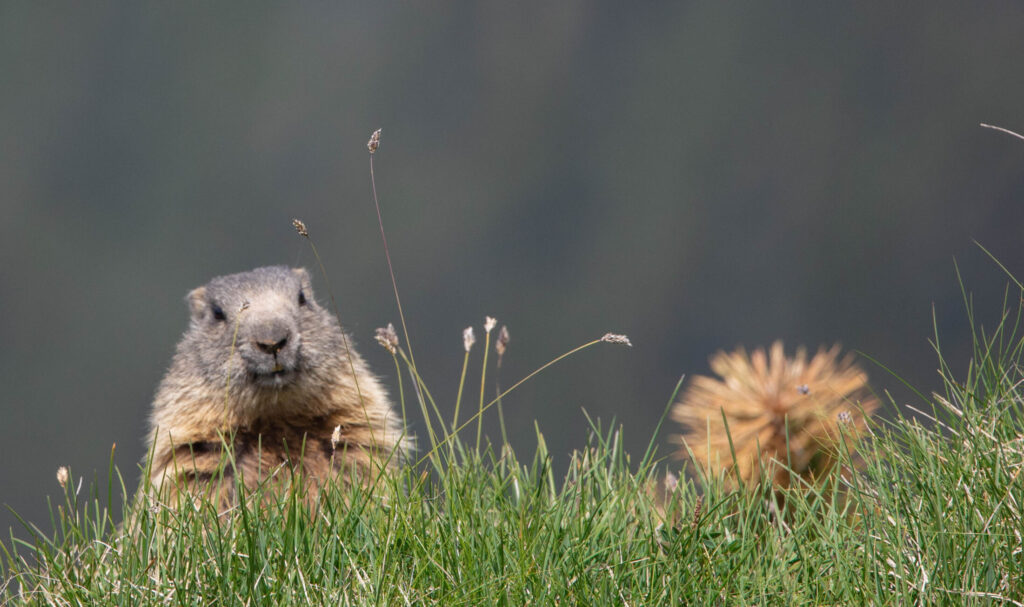
That being said, there are pros and cons to visiting in each season, which I’ve summarized below.
Insider tip #3: In addition to the points below, if you’re travelling without a car, keep in mind that public transportation options will generally be more limited in the fall, winter, and spring, with bus routes running less frequently and many cable cars closed.
| Season | Pros | Cons | Best activities to do |
|---|---|---|---|
| Spring | Fewer tourists, lower prices | Cool temperatures, mountain huts and many businesses closed, snow in some areas | Hiking in lower elevation areas |
| Summer | Great weather, wildflowers in full bloom | Busy with many tourists, higher prices (especially in August, with the peak during Ferragosto, the Italian holiday period) | Hiking, mountain biking |
| Autumn | Fewer tourists, lower prices, autumn colours | Cool temperatures, mountain huts and many businesses closed, snow in some areas | Hiking |
| Winter | Perfect for skiing and snow sports | Hiking is more challenging | Skiing, snowboarding, snowshoeing and many other snow sports |
The itinerary I’ve provided is based on visiting during the summer. It may still be doable in the shoulder season (late spring and early fall), though some trailheads, towns and other points of interest may be closed or more difficult to get to.
The bottom line: If you’re interested in hiking and you’re travelling without a car, summer is the most convenient time to visit because all buses and cable cars run at their maximum frequencies. To avoid the tourist crowds, target the very beginning of the season (late June) or the very end (late September).
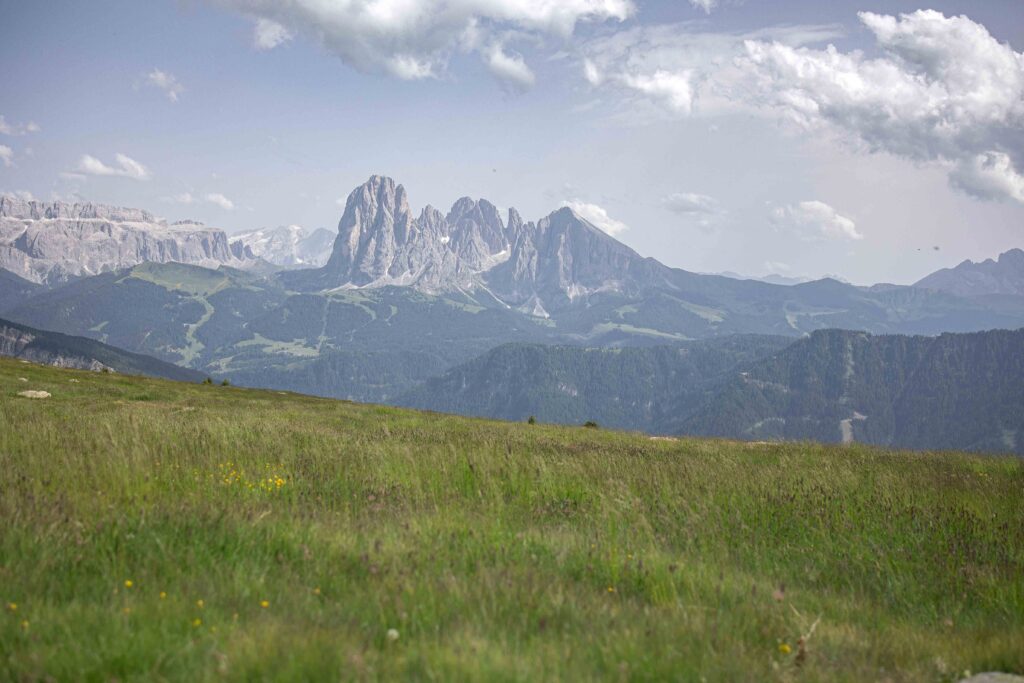
7. Perfect itinerary for 5 days in the Dolomites (without a car needed)
Day 1: Hiking Resciesa to Seceda
For your first day, dust off your hiking shoes and get ready to dive into the beauty of the Dolomites, with a panoramic 14 km trek across the Resciesa mountain plateau to the staggering Seceda ridgeline. The hike will take you on an elevation gain of just over 1000 metres, so unless you’ve been training, you will be pretty tuckered out by the end, but the views are so worth it!
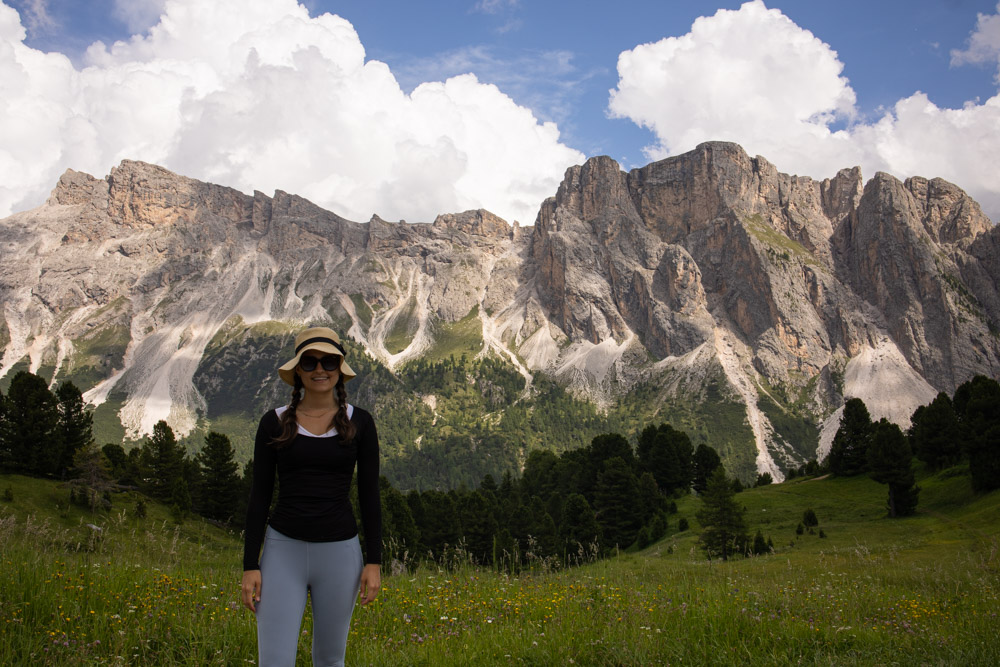
Day 2: Paragliding over Val Gardena and exploring Alpe di Siusi
Day 2 gives you a chance to recover from the long hike from the day before while getting a true bird’s eye view of Val Gardena by spending the morning paragliding across the valley.
In the afternoon, take a leisurely hike around Alpe di Siusi. The trails are well maintained and relatively flat, and it’s one of the most beautiful areas in the Dolomites, in my opinion.
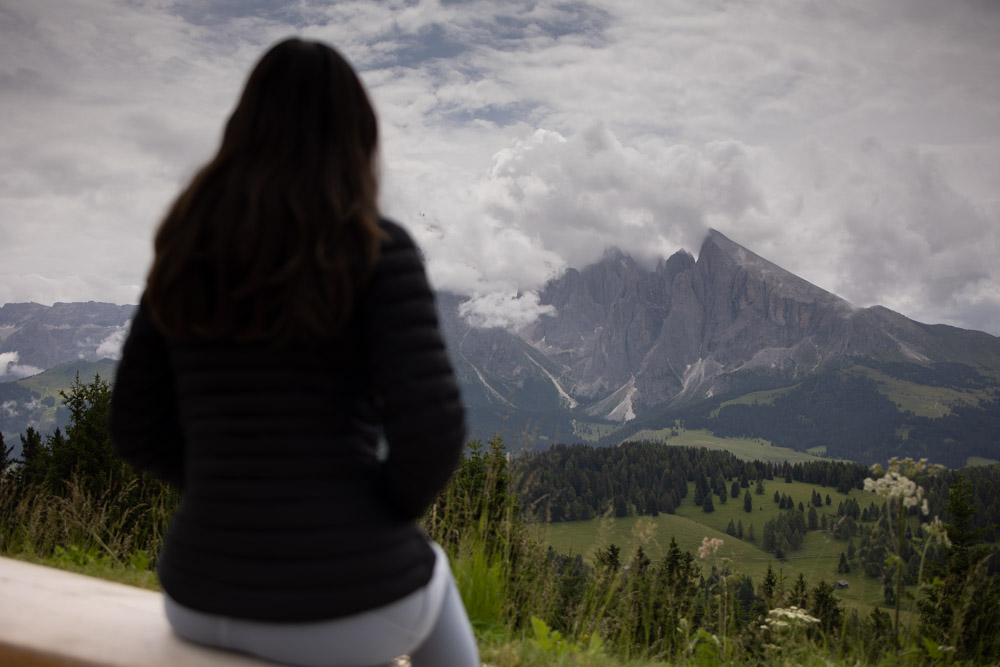
Day 3: Hiking around the base of the Sassolungo Group
On day 3, you’ll get to admire all the wild faces of the towering Sassolungo group of mountains during a challenging but ever so scenic 17 km loop, climbing and descending about 800 m.
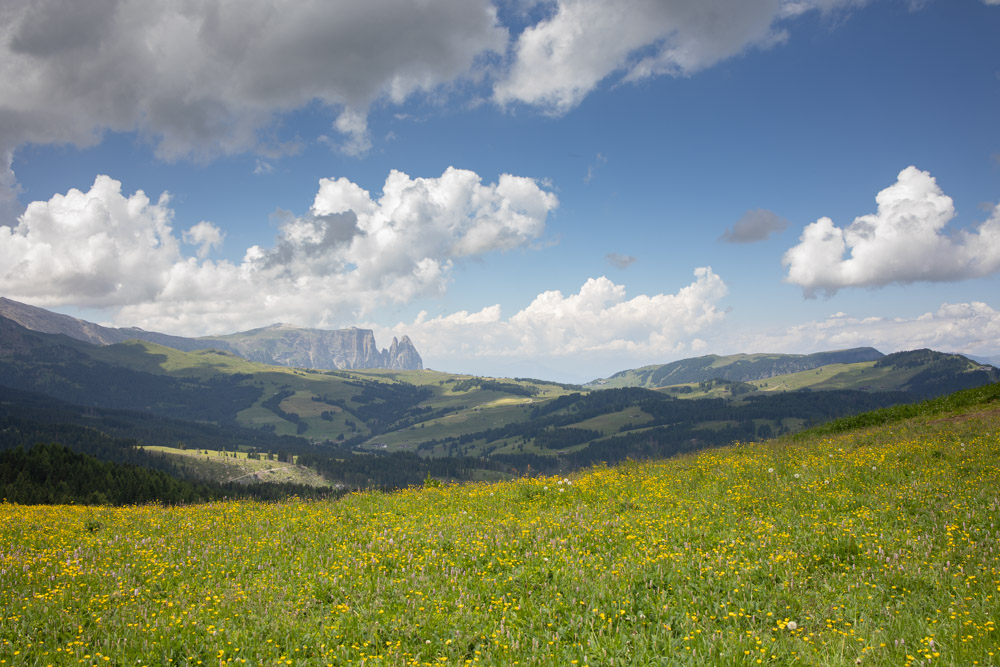
Day 4: Resciesa summit loop
On day 4, you’ll go back to Resciesa, this time hiking 5 km and ascending 185 m to the summit, where you’ll enjoy breathtaking panoramic views of the surrounding area.
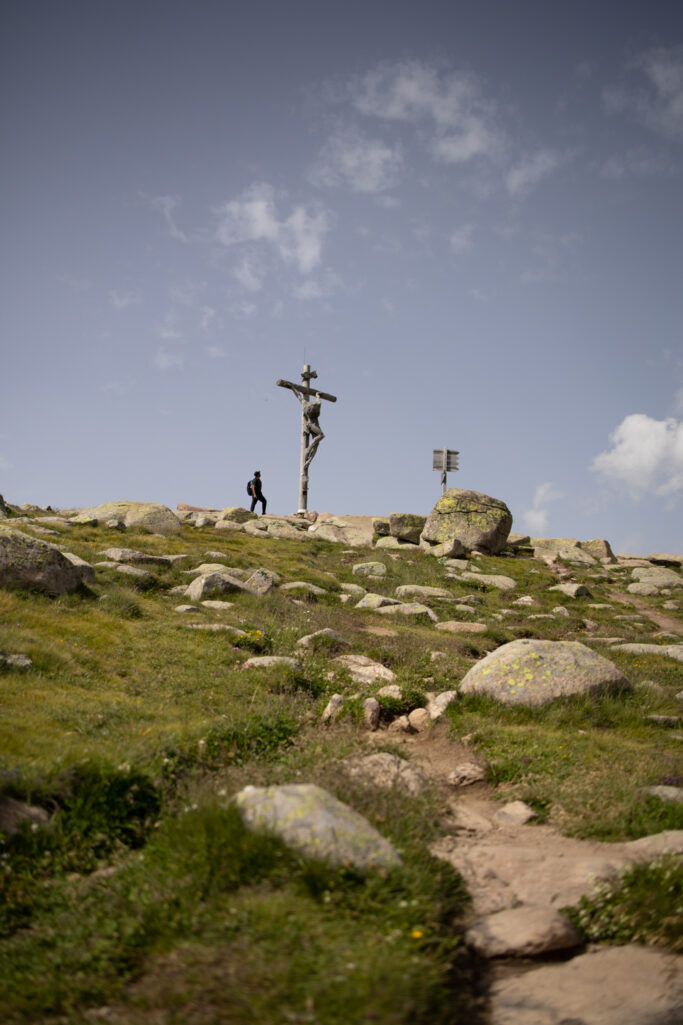
Day 5: Exploring the Vallunga and spa afternoon
For the last day, take it easy and explore the Vallunga valley in the heart of the Puez Odle Nature Park. Keep an eye out for wildlife, including deer and chamois in the steep meadows and rocky walls on either side of the hiking trail, as well as for eagles soaring above!
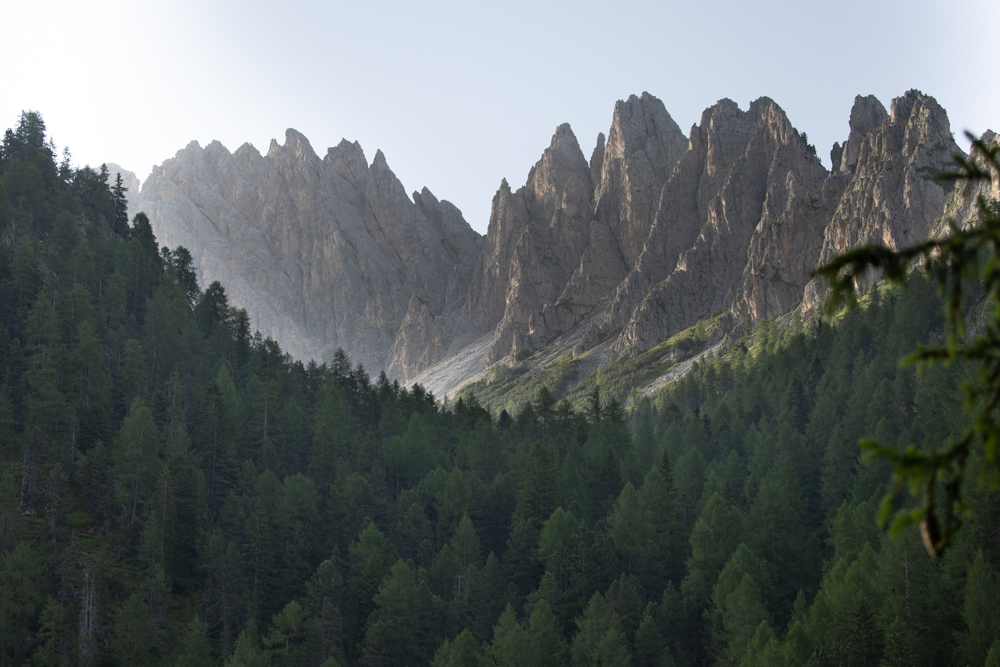
Before you leave, take the afternoon to get some well deserved R&R and perhaps a massage at one of the many world class wellness centres in the area.
Bonus activities
There are a couple of things that I didn’t get to do on my first trip to the Dolomites that I definitely want to do when I go back, including climbing a via ferrata and a hut to hut hike. For details about these and the other activities outlined in this itinerary, make sure to check out my other post, The perfect 5 day Dolomites itinerary without a car.
8. How to get around Ortisei and Val Gardena without a car
Free public transportation
As mentioned, overnight visitors of Val Gardena receive a Mobil card, with provides free access to transportation in Val Gardena. This makes it easy and inexpensive to travel between the towns / villages (Ortisei, Santa Cristina and Selva) and explore the whole valley.
You can plan your trips using their journey planner.
Lifts and cable cars
There are many lifts scattered throughout Val Gardena that save you from having to ascend to the various sights and trailheads and give you more time to explore the tops of the mountains. You will use them for most hikes that you do as part of this itinerary, although we did see people walking up the trails, so it’s possible!
Purchasing a Gardena Card
Purchasing a Gardena Card allows you to use of all local lift facilities in the summer. The card can easily get you to destinations including the Seceda, Alpe di Siusi, Col Raiser, and Monte Pana. Check out my perfect 5 day Dolomites itinerary without a car for more info on the Gardena Card.
Bicycle
e-Bikes and mountain bikes are another popular way to explore the mountains. I didn’t get to try it on my own trip, but hope to someday!
9. What to eat and drink in the Dolomites
There is no shortage of delicious things to eat and drink in the Dolomites – below are just some of our favourites . 🙂
Charcuterie at a mountain hut
Stopping at a mountain hut for some charcuterie and a drink is part of the experience of hiking the Dolomites. And not all huts are made equal.
On the Seceda, there is Curona Baita, a hut where we had amazing, local, artisan charcuterie with incredible views.
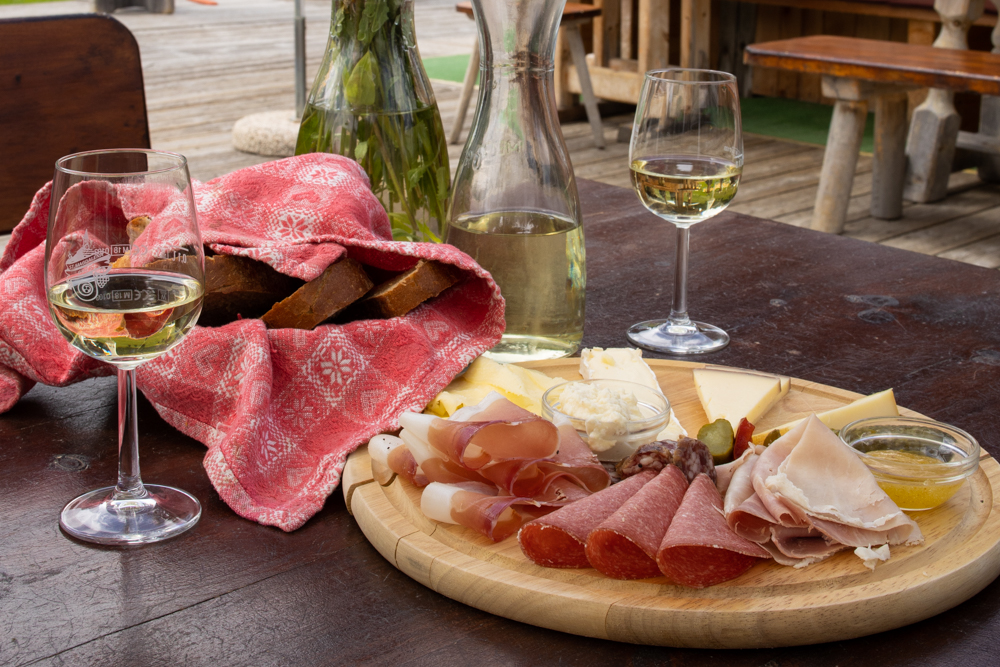
Traditional South Tyrolean cuisine
Try out some traditional local South Tyrolean cuisine for dinner at Mauriz Keller. The portions are generous and the ambiance is warm. They have a large menu and in addition to South Tyrolean specialties, they also serve a good selection of popular Italian dishes, including wood-fire oven pizza.

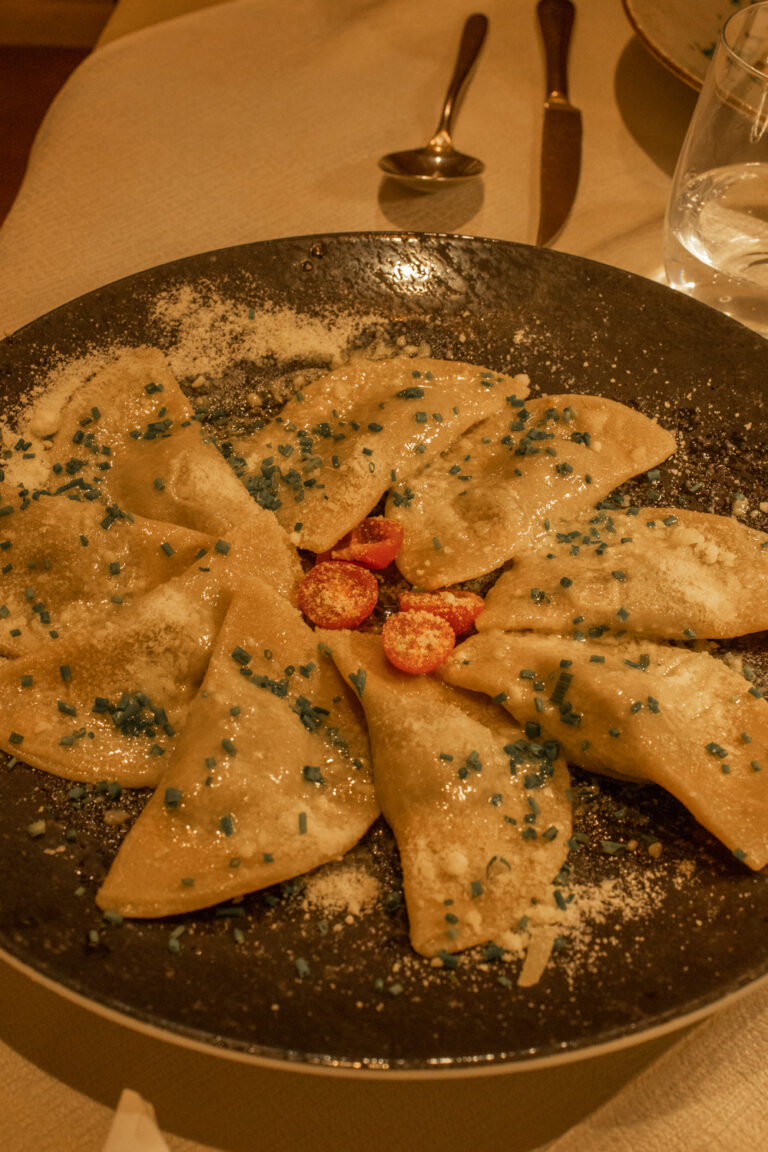
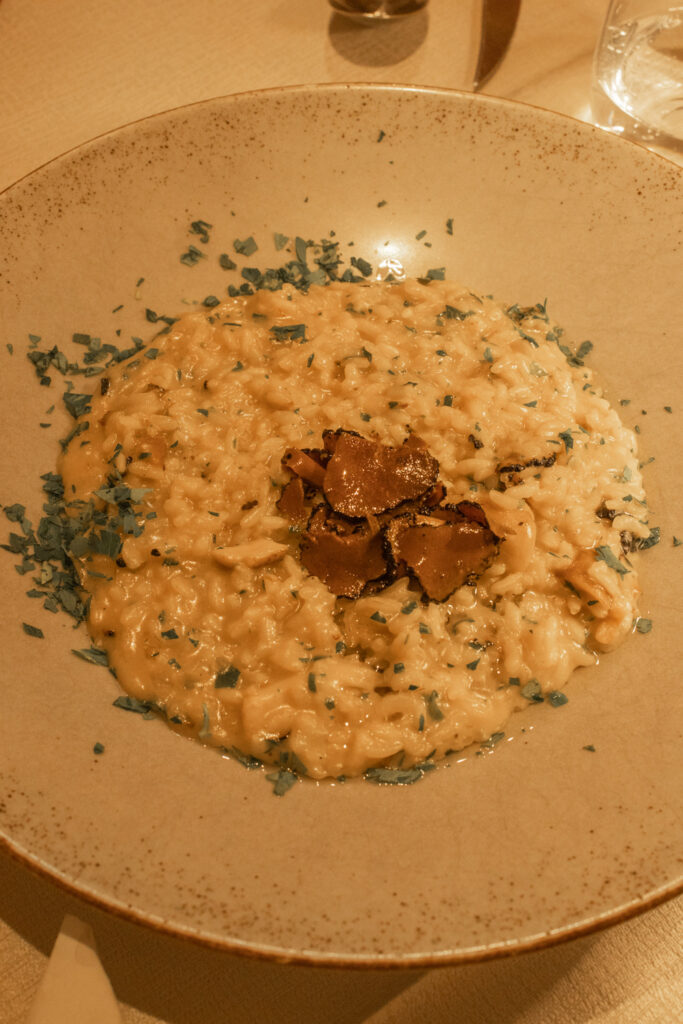
Pizza
Nothing hits the spot after a long day of hiking like some pizza and wine! You have to try Turonda, a pizzeria and bistro in Ortisei (that we went to twice during our stay… oops). Their pizzas are truly divine. You can choose from several styles of dough, made with different types of flour, varying fermentation times, and unique cooking methods. The place does cater to a Western customer, so I wouldn’t necessarily come to experience traditional South Tyrolean food, but the pizza is bomb!
For amazing sunset views of the mountains, ask to sit on the outdoor patio. 🙂

Pack your own gourmet deli sandwiches
The grocery stores in Ortisei are stacked with the best meats, cheeses and spreads you could imagine. Huzai and I really enjoyed picking out the bread along with the other ingredients we wanted and putting together our own gourmet sandwiches. You can take them on your hikes and enjoy them high up in the mountains 🙂

